
Hans Hollein was an Austrian architect and designer and key figure of postmodern architecture. Some of his most notable works are the Haas House and the Albertina extension in the inner city of Vienna.
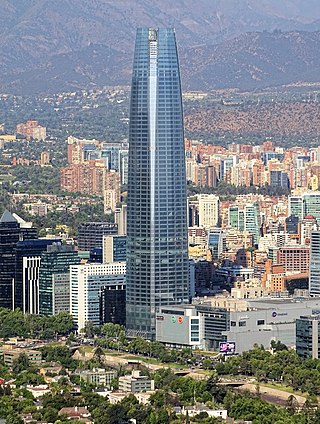
Gran Torre Costanera, previously known as Costanera Center Torre 2, and also known as El Costanera by the locals, and previously known as Torre Gran Costanera, is a 62-story skyscraper in Santiago, Chile. It is the tallest building in South America, the second tallest building in Latin America and the fifth tallest building in the Southern Hemisphere. The tower was designed by Chilean architects Alemparte Barreda & Asociados, the Argentine architect César Pelli and the Canadian company Watt International.

The Iberdrola Tower is an office skyscraper in Bilbao, Spain. Its construction started on 19 March 2009 and was officially inaugurated by King Juan Carlos I on 21 February 2012. The tower has a height of 165 metres (541 feet) tall and has 40 floors. The first eight floors of the tower were to hold a hotel by the Spanish hotel chain ABBA, but the project was eventually cancelled. The hotel will be replaced by an auditorium with the capacity of 200 people. The remaining floors have an office usage. The tower, built as Iberdrola's headquarters, is the tallest building in the Basque Country and the city of Bilbao, and the eighth tallest building in Spain.

Titanium La Portada is an office building in Santiago, Chile. Located in the capital's high-end financial district of El Golf, it is the second tallest skyscraper in the country. Construction began in January 2007, and was completed in January 2010. It was surpassed in height by the then unfinished Gran Torre Santiago in November 2010. It was officially inaugurated on May 3, 2010. The architects are Abraham Senerman and Andrés Weil.
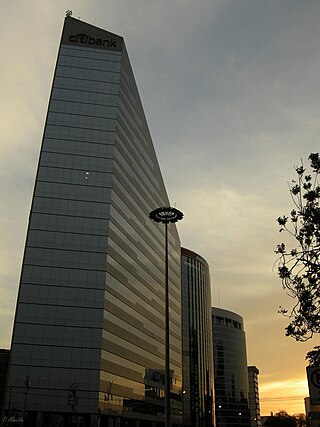
The Chocavento Tower is a high-rise office building located in the San Isidro district of Lima, Peru, built in 2001. At a height of 107 meters, is the third highest building in Peru, surpassed by the "Centro Civico de Lima" at 109 meters, the "Westin Libertador Hotel" at 120 meters and the "Banco Continental (BBVA) Building" at 132 meters. The Chocavento building has 25 storeys above ground and five below ground. Its construction cost US$15.3 million.

Edificio Miguel E Abed, located on Eje Central Lázaro Cárdenas #13 in the Historic Center of Mexico City, opposite the Torre Latinoamericana. It was built by Mexican-Lebanese businessman Miguel E. Abed who was also one of the founders of the Centro Libanes in Mexico City along with former president Miguel Avila Camacho. The building is equipped with three high-speed elevators (lifts) which move at 6.0 meters per second. In the building are offices of various companies, that are installed since the early 1960s. In 1952, the building exceeded the Tower Anahuac for four years, to become the tallest building in Mexico until 1956 - the year in which construction was completed on the tallest building in Latin America for its time, the Torre Latinoamericana.

The Bank of Spain building is an eclectic early-20th-century building in the Spanish city of Pontevedra.

The Castelao building is a modern architectural building from the beginning of the 21st century located on the corner of Padre Amoedo Carballo and Sierra Street in Pontevedra, Spain, on the edge of the historic centre. It belongs to the Pontevedra Museum.
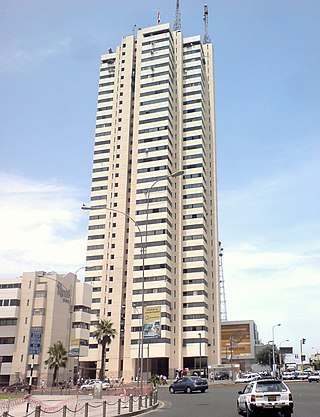
The Lima Civic Center is an architectural complex located next to the Paseo de los Héroes Navales in the district of Lima, on the land previously occupied by the Lima Penitentiary. It was projected with the intention of becoming a civic-urban landmark for the city, housing State offices, a hotel and a convention center. Its construction began in 1970 and culminated in 1977 with the inauguration of the main tower of the complex. At 109 meters tall, it was the tallest building in the country for 34 years. It was surpassed in 2011 by the Westin Hotel in the San Isidro district.

The Bank of the Nation Tower is a multi-purpose building in Lima and the tallest building in Peru. It serves as the headquarters of the Bank of the Nation, after which it's named.

The Javier Alzamora Valdez Building is located in the historic center of Lima, Peru. It stands at the intersection of Abancay and Colmena avenues, next to the University Park. Formerly the headquarters of the Ministry of Education, it's the main location of the Superior Court of Justice of Lima, part of the Judiciary of Peru.
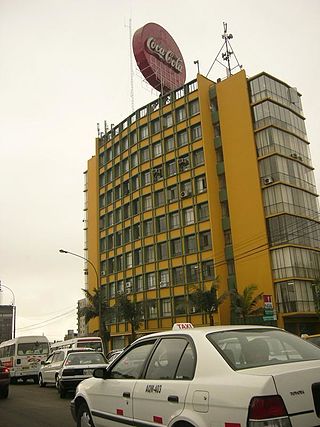
The Limatambo Building, also known as the Seoane Building, was a building in Lince District, Lima. The building was known for its billboards, most of which promoted the Coca-Cola Company.

Democracy Square is a public square in the Historic Centre of Lima, Peru. It is located on the former site of the Bank of the Nation Building, which burned down in the year 2000 during the Four Quarters March. The park's address is 1045 Nicolás de Piérola Avenue.

The Calle García Camba is a street in Pontevedra (Spain) located in the city centre, in the first urban expansion area. It is one of the main streets of Pontevedra.
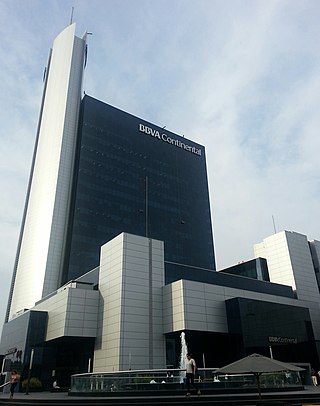
The BBVA Building, also known as the Banco Continental Building, is a building located in Republic of Panama Avenue 3055, in San Isidro District, Lima. The second tallest building in Peru, it serves as the main headquarters of BBVA Perú, a subsidiary of Spanish financial company Banco Bilbao Vizcaya Argentaria (BBVA).

Begonias Tower, also known as the HSBC Tower, is a skyscraper located in San Isidro District, Lima.

The Museum of the Central Reserve Bank of Peru, known also as the BCRP Museum or simply Central Museum, is an archaeological, numismatic and artistic museum of the Central Reserve Bank of Peru, located at the corners of Lampa and Ucayali streets, in the historic centre of Lima, Peru.

The Atlas Building is a building designed by architect Walter Weberhofer with José Álvarez Calderón, located in the corners of Huancavelica and Caylloma streets in the historic centre of Lima, Peru. Built in 1955, it is located in the district of Lima. The building won the Gold Medal from the Municipality of Lima for Best Building of 1955, awarded on the Fiestas Patrias.




















